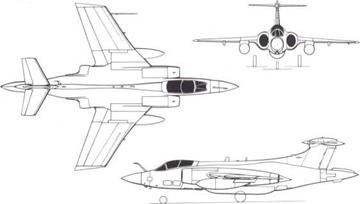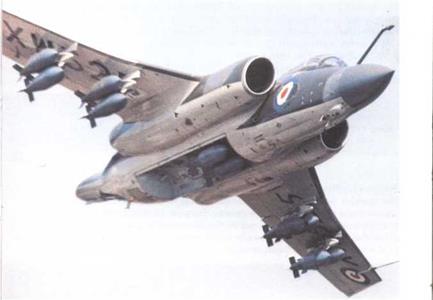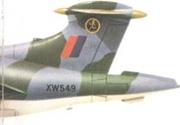HSA (BAe) Buccaneer
Buccaneer S.1,2, 2A, 2B, 2C, 2D and 50
Origin: Hawker Siddeley Aviation (formerly Blackburn Aircraft, now British Aerospace), UK.
Type: Two-seat attack and reconnaissance.
Engines: (S.1) two 7,1001b (3220kg) thrust Bristol Siddeley (previously de Havilland) Gyron Junior 101 single-shaft turbojets; (all later marks) two 11,0301b (5003kg) Rolls-Royce Spey 101 two-shaft turbofans. Dimensions: Span (1) 42ft 4in (1 2-9m); (2 and subsequent) 44ft (1 341 m); length 63ft 5:n (19-33m); height 16ft 3in (4 95m).
Weights: Empty (1) 26,000lb (2) about 30,0001b (13,610kg); maximum loaded (1) 46,000lb (20,865kg); (2) 62,000lb (28,123kg).
Performance: Maximum speed (all) 645mph (1038km/h, Mach 0-85) at sea level; initial climb (2, at 46,0001 b) 7,000ft (2134m)/min; service ceiling not disclosed but over 40,000ft (9144m); range on typical hi-lo-hi strike mission with weapon load (2) 2,300 miles (3700km).
Armament: Rotating bomb door carries four 1,0001b (454kg) bombs or multi-sensor reconnaissance pack or 440gal tank; (S.2 and later) four wing pylons each stressed to 3,0001b (1 361 kg), compatible with very wide range of guided and/or free-fall missiles. Total internal and external stores load 16,0001b (7257kg).
History: First flight (NA.39) 30 April 1958; (production S.1) 23 January 1962; (prototype S.2) 17 May 1963; (production S.2) 5 June 1964; final delivery late 1 975.
Users: S Africa, UK (RAF, Royal’Navy).
Development: After the notorious "Defence White Paper" of April 1957, which proclaimed manned combat aircraft obsolete, the Blackburn B.103, built to meet the naval attack specification NA.39, was the only new British military aircraft that was not cancelled. Development was grudgingly permitted, and this modest-sized subsonic machine was gradually recognised as a world-beater. Designed for carrier operation, its wing and tail were dramatically reduced in size as a result of very powerful tip-to-tip supercirculation (BLC, boundary-layer control) achieved by blasting hot compressed air bled from the engines from narrow slits. The S.1 (strike Mk 1) was marginal on power, but the greatly improved S.2 was a reliable and formidable aircraft. The first 84 were ordered by the Royal Navy and most of these have been transferred to RAF Strike Command, designated S.2B when converted to’launch Martel missiles. Those remaining with the Navy are S.2Ds (2C if they are not Martel-compatible), In January 1963 the South African Air Force bought 16 S.50s with BS.605 boost rocket built into a retractable pack in the rear fuselage to facilitate use from hot and high airstrips. Finally – perhaps rather surprisingly, considering the scorn vented on Buccaneer during the TSR.2 era — the RAF signed in 1 968 for 43 new S.2Bs with adequate equipment, including a refuelling probe which is never used in front-line service in Germany. Within the limits of crippling budgets the RAF Buccaneers have been updated by improved avionics and ECM, and all
 |
Below: A Buccaneer S.2B of RAF No 16 Sqn which, with No 15, forms the attack/strike force of RAF Germany based at Laarbruch.

Three-view of Buccaneer S.2 with FR probe and bomb-door tank.

models have the advantage of an unbreakable long-life airframe and the ability to carry weapons internally In 1977 they were getting Pave Spike laser-guided bomb systems. Altogether the Mk 2 Buccaneer is one of the most cost/effective aircraft ever designed for tactical use.
 Above: This Buccaneer is seen with its rotary weapon-bay door open, revealing the internal bay which enables it to attack in the clean condition at speeds higher than the maximum speed at sea level of many so-called supersonic attack aircraft (which can reach supersonic speed only at high altitude and carry their weapons outside).
Above: This Buccaneer is seen with its rotary weapon-bay door open, revealing the internal bay which enables it to attack in the clean condition at speeds higher than the maximum speed at sea level of many so-called supersonic attack aircraft (which can reach supersonic speed only at high altitude and carry their weapons outside).










